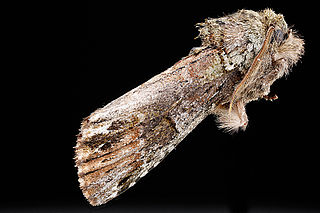
Notodontidae is a family of moths with approximately 3,800 known species. The family was described by James Francis Stephens in 1829. Moths of this family are found in all parts of the world, but they are most concentrated in tropical areas, especially in the New World.

Americerura scitiscripta, the black-etched prominent, is a moth of the family Notodontidae. It is found from Quebec west to eastern Alberta, south to Florida and Texas. The species was formerly placed the genus Tecmessa, and the genus Cerura, which is now restricted to the Old World.

Cecrita guttivitta, the saddled prominent moth, is a species of moth of the family Notodontidae. It is found in North America, including Alabama, Arkansas, Connecticut, Delaware, Florida, Georgia, Illinois, Indiana, Iowa, Kansas, Kentucky, Maine, Maryland, Massachusetts, Minnesota, New Brunswick, New Hampshire, New Jersey, New York, North Carolina, Ohio, Oklahoma, Ontario, Pennsylvania, South Carolina, Tennessee, Vermont, Virginia, West Virginia and Wisconsin.

Coelodasys unicornis, the unicorn caterpillar moth, unicorn prominent or variegated prominent, is a species of moth in the family Notodontidae. It was first described by James Edward Smith in 1797 and is found in North America south of the Arctic.
Erbessa albilinea is a moth of the family Notodontidae first described by James S. Miller in 2008. It is found in Costa Rica.
Erbessa lamasi is a moth of the family Notodontidae first described by James S. Miller in 2008. It is found in south-eastern Peru.
Erbessa pyraloides is a moth of the family Notodontidae first described by Francis Walker in 1854. It is found in Brazil, Colombia and Venezuela.
Erbessa stroudi is a moth of the family Notodontidae first described by James S. Miller in 2008. It is found on the slopes of the Cordillera Central in northern Costa Rica.
Phaeochlaena costaricensis is a moth of the family Notodontidae first described by James S. Miller in 2008. It is found in Costa Rica and Panama.
Polypoetes copiosa is a moth of the family Notodontidae. It has a restricted distribution along the foothills of the Andes in western Ecuador.
Brachyglene albicephala is a moth of the family Notodontidae first described by James S. Miller in 2008. It is endemic to the northern half of Costa Rica.
Nebulosa elicioi is a moth of the family Notodontidae first described by James S. Miller in 2008. It is endemic to the eastern slope of the Ecuadorian Andes.
Nebulosa yanayacu is a moth of the family Notodontidae first described by James S. Miller in 2008. It is found along the eastern slope of the Ecuadorian Andes.
Stenoplastis dyeri is a moth of the family Notodontidae. It is found on the eastern side of the Andes in Ecuador.
Tithraustes noctiluces is a moth of the family Notodontidae. It is found in Panama, Costa Rica and El Salvador.
Tithraustes snyderi is a moth of the family Notodontidae. It is found in cloud-forest habitats within La Amistad, an international park extending from south-central Costa Rica into the Chiriqui Province of Panama.
Dunama mattonii is a moth in the family Notodontidae. It is found in Ecuador.
Xenomigia noctipenna is a moth of the family Notodontidae. It is found in north-eastern Ecuador.
Xenomigia phaeoloma is a moth of the family Notodontidae. It is found in north-eastern Ecuador.
Xenomigia wilmeri is a moth of the family Notodontidae first described by James S. Miller in 2011. It is found in north-eastern Ecuador.



